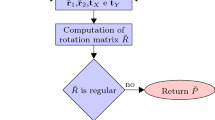Abstract
Camera calibration and 3D reconstruction are important issues in computer vision. Two applications of bracket algebra in these two issues are presented in this work. Firstly, a camera calibration method is proposed, which is from only distance ratios of object points. Thanks to the effective computations of brackets, this method does not need to set up any world coordinate system and thus can use the geometric information of irregular objects conveniently. Secondly, we represent the reconstruction solution of plane structure directly from four known control points and give some new and useful error analysis results. The solution based on brackets is concise and short, and the error analysis results can act as a theoretical guidance in practice. Simulations and experiments on real images validate our proposed camera calibration method, direct reconstruction solution and error analysis results.
Similar content being viewed by others
References
Y.I. Abdel-Aziz and H.M. Karara, “Direct linear transformation from comparator coordinates into object space coordinates in close-range photogrammetry,” in Proc. ASP/UI Symp. on Close-Range Photogrammetry, Urbana, Illinois, Jan. 1971, pp. 1–18.
M.A. Abidi and T. Chandra, “A new efficient and direct solution for pose estimation using quadrangular targets: Algorithm and evaluation,” IEEE Trans, on Pattern Analysis and Machine Intelligence, Vol. 17, No. 5, pp. 534–538, 1995.
E. Bayro-Corrochano and V. Banarer, “A geometric approach for the theory and applications of 3D projective invariants,” Journal of Mathematical Imaging and Vision, Vol. 16, No. 2, pp. 131–154, 2002.
E. Bayro-Corrochano, J. Lasenby, and G. Sommer, “Geometric algebra: A framework for computing point and line correspondences and projective structure using n uncalibrated cameras,” in the 13th Int. Conf. on Pattern Recognition, Vienna, Austria, Aug. 1996, pp. 334–338.
S. Carlsson, “Symmetry in perspective” in ECCV, Freiburg, Germany, June 1998, pp. 249–263.
A. Criminisi, “Single-view metrology: Algorithms and applications,” in DAGM-Symposium, Zurich, Sept. 2002, pp. 224–239.
A. Criminisi, Accurate Visual Metrology from Single and Multiply Images. Distingiushed Dissertation Series. Springer-Verlag London Ltd., Sept. 2001.
A. Criminisi, I. Reid, and A. Zisserman, “Single view metrology,” in ICCV, Corfu, Greece, Sept. 1999, pp. 434–442.
A. Criminisi, I. Reid, and A. Zisserman, “A plane measuring device,” Image and Vision Computing, Vol. 17, No. 8, pp. 625–634, 1999.
G. Csurka and O. Faugeras, “Algebraic and geometric tools to compute projective and permutation invariants,” IEEE Trans. on Pattern Analysis and Machine Intelligence, Vol. 21, No. 1, pp. 58–65, 1999.
R.M. Haralick, “Determining camera parameters from the perspective projection of a rectangle,” Pattern Recognition, Vol. 22, No. 3, pp. 225–230, 1989.
R. Hartley and A. Zisserman, Multiple View Geometry in Computer Vision, Cambridge University Press, 2000.
FA van den Heuvel, “Exterior orientation using coplanar parallel lines,” in the 10th Scandinavian Conference on Image Analysis, Lappeenranta, Finland, June 1997, pp. 71–78.
J. Lasenby, E. Bayro-Corrochano, A. Lasenby, and G. Sommer, “A new methodology for computing invariants in computer vision,” in the 13th Int. Conf. on Pattern Recognition, Vienna, Austria, Aug. 1996, pp. 393–397.
R. Lee, P.C. Lu, and W.H. Tsai, “Robot location using single views of rectangular shapes,” PE&RS, Vol. 56, No. 2, pp. 231–238, 1990.
S. Maybank, “Relation between 3D and 2D invariants,” Image and Vision Computing, Vol. 16, pp. 13–20, 1998.
L. Mundy and A. Zisserman (Eds.), Geometric Invariance in Computer Vision, The MIT Press: Cambridge, Mass., 1992.
I. Reid and A. Zisserman, “Goal-directed video metrology,” in ECCV, Cambridge, UK, April 1996, pp. 647–658.
P. Sturm, “Algorithms for plane-based pose estimation,” in CVPR, Hilton Head Island, South Carolina, June 2000, pp. 706–711.
B. Sturmfels, Algorithms in Invariant Theory, Springer-Verlag: Wien New York, 1993.
N.L. White (Ed.), “Invariant methods in discrete and computational geometry,” in Proc. Curacao Conference, Kluwer Academic Publishers, June 1994.
M. Wilczkowiak, E. Boyer, and P. Sturm, “3D modeling using geometric constraints: A parallelepiped based approach,” in ECCV, Copenhagen, Denmark, May 2002, pp. 221–236.
M. Wilczkowiak, E. Boyer, and P. Sturm, “Camera calibration and 3D reconstruction from single images using parallelepipeds,” in ICCV, Vancouver, Canada, July 2001, pp. 142–148.
Y.H. Wu, Bracket Algebra, Affine Bracket Algebra and Automated Geometric Theorem Proving. Ph.D. Dissertation, Institute of Systems Science, Chinese Academy of Sciences, Beijing, June 2001.
Y.H. Wu and Z.Y. Hu, “Invariant representations of a quadric cone and a twisted cubic,” IEEE Trans. on Pattern Analysis and Machine Intelligence, Vol. 25, No. 10, pp. 1329–1332, 2003.
Z. Zhang, “A flexible new technique for camera calibration,” IEEE Trans. on Pattern Analysis and Machine Intelligence, Vol. 22, No. 11, pp. 1330–1334, 2000.
Author information
Authors and Affiliations
Corresponding author
Additional information
Yihong Wu received her Doctor of Science degree in Geometric Invariants and Applications from MMRC, Institute of Systems Science, Chinese Academy of Sciences, in 2001. From June 2001 to July 2003, she did her postdoctoral research in NLPR, Institute of Automation, Chinese Academy of Sciences. After then, she joined NLPR as an associate professor. Her research interests include polynomial elimination and applications, geometric invariant and applications, automated geometric theorem proving, camera calibration, camera pose determination, and 3D reconstruction etc.
Zhanyi Hu received the B.S. Degree in Automation from the North China University of Technology in 1985, the Ph.D. Degree (Docteur d’Etat) in Computer Science from the University of Liege, Belgium, in Jan. 1993. Since 1993, he has been with the Institute of Automation, Chinese Academy of Sciences. From May 1997 to May 1998, he also acted as a visiting scholar of Chinese University of Hong Kong on invitation. Dr. Hu now is a Research Professor of Computer Vision, a member of the Executive Expert Committee of the Chinese National High Technology R&D Program, a deputy editor-in-chief for Chinese Journal of CAD and CG, and an associate editor for Journal of Computer Science and Technology. His current research interests include Camera Calibration, 3D Reconstruction, Feature Extraction, and Vision Guided Robot Navigation etc.
Rights and permissions
About this article
Cite this article
Wu, Y., Hu, Z. Camera Calibration and Direct Reconstruction from Plane with Brackets. J Math Imaging Vis 24, 279–293 (2006). https://doi.org/10.1007/s10851-005-3628-9
Published:
Issue Date:
DOI: https://doi.org/10.1007/s10851-005-3628-9




